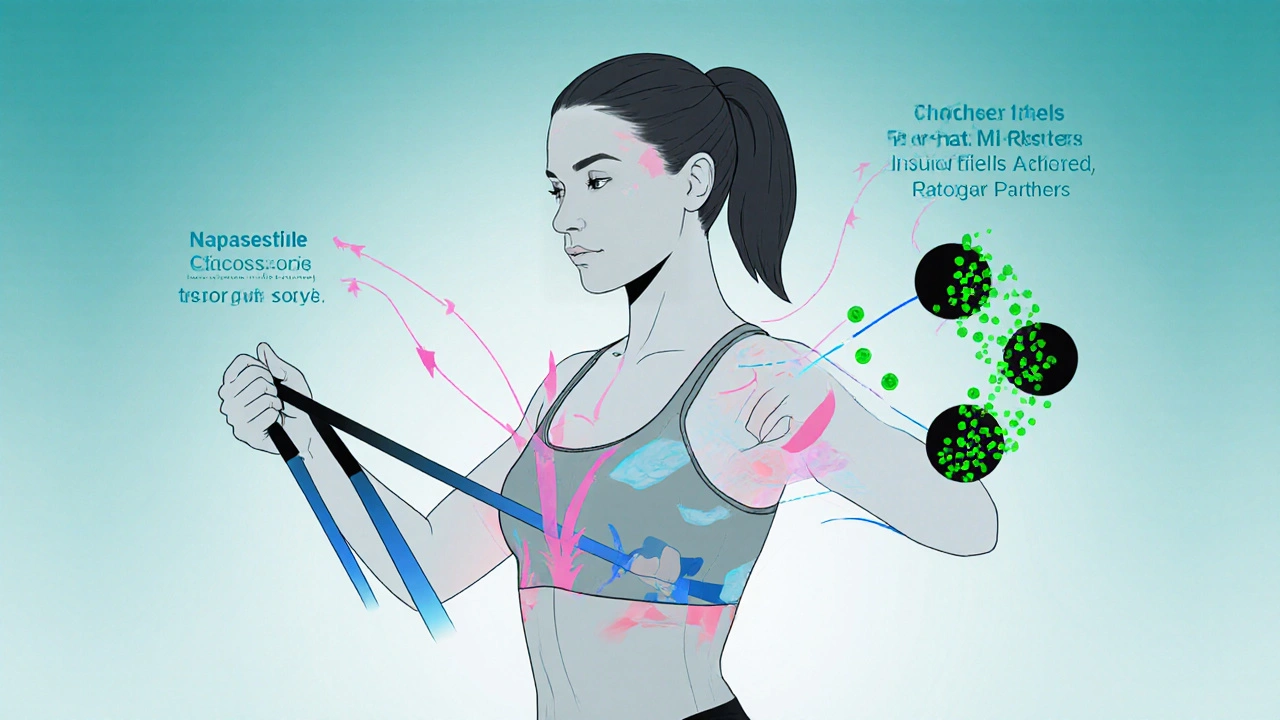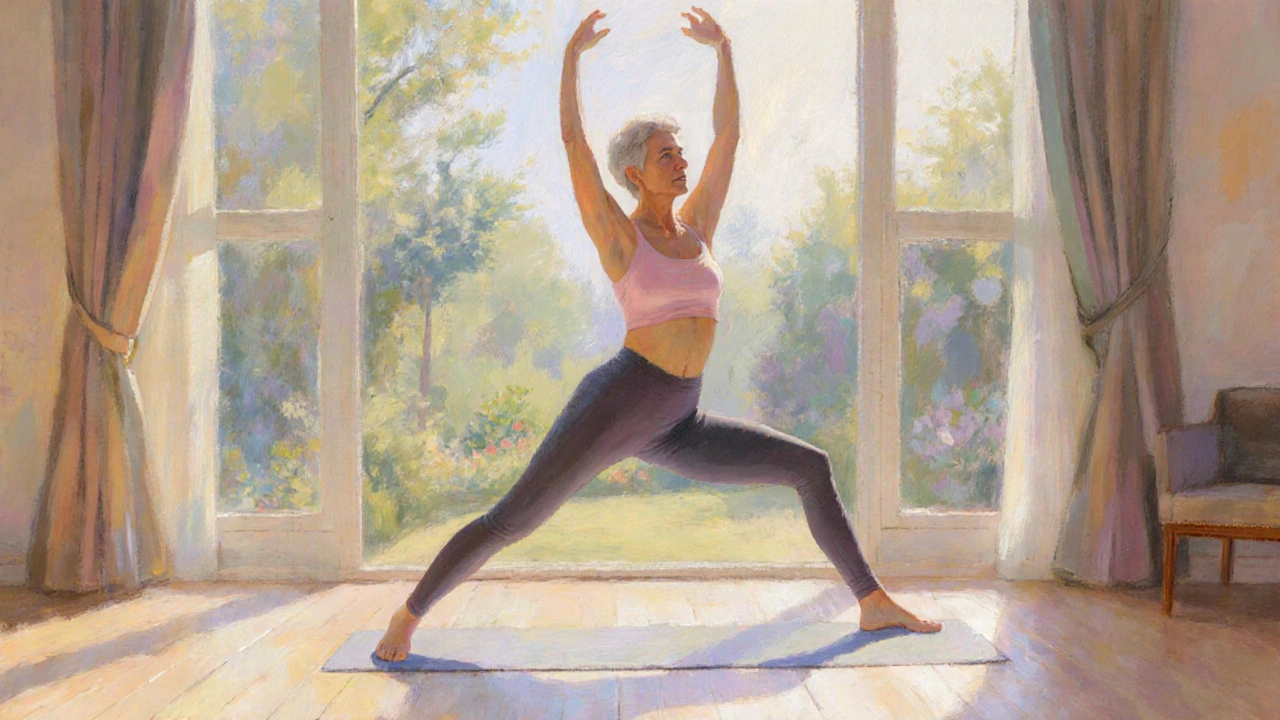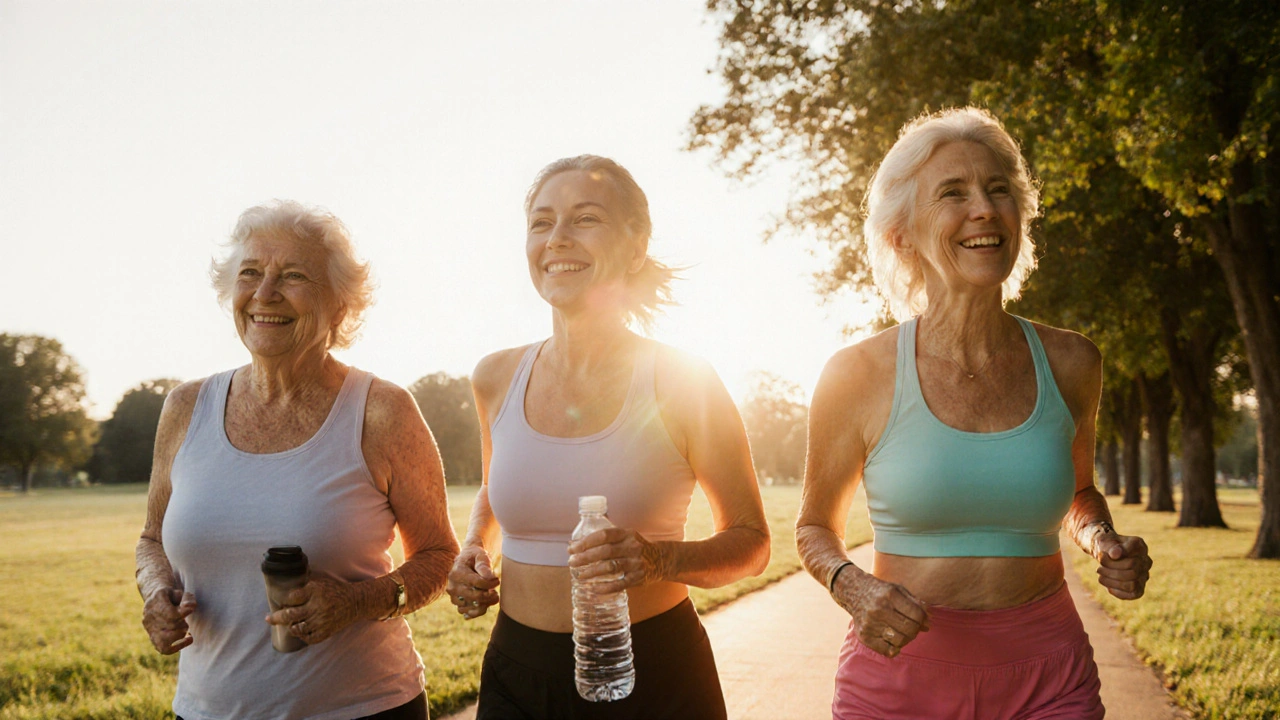Breast Cancer Exercise Planner
Get Your Personalized Exercise Plan
Select your current stage to receive tailored recommendations:
Your Recommended Exercise Plan
Select your journey stage to see your personalized plan.
Key Safety Considerations
Before you start: Always get medical clearance from your oncology team, especially if you have a central line, surgical implants, or lymphedema.
Listen to your body: Sore muscles are normal, but sharp pain is a red flag. Adjust intensity if you experience severe fatigue or discomfort.
What to Avoid
- Over-training (increase by only 5-10 minutes weekly)
- Skipping warm-ups/cool-downs
- Heavy lifting during early recovery
- Ignoring lymphedema symptoms (tightness, swelling)
Did you know that regular exercise breast cancer can slash a woman’s risk of developing the disease by up to 30%? Whether you’re a survivor, a caregiver, or simply curious about staying healthy, understanding how movement fights breast cancer can change the way you plan your daily routine.
When we talk about Exercise is a planned, structured, and repetitive bodily activity that improves or maintains physical fitness, its impact reaches far beyond muscle tone. It touches hormones, immune cells, and even the way cancer cells grow.
Why Exercise Matters for Breast Cancer Prevention
Research from the World Health Organization and the American Cancer Society shows that women who meet the recommended 150 minutes of moderate‑intensity activity each week have a noticeably lower incidence of breast cancer. Three main mechanisms drive this protection:
- Hormone regulation: Physical activity lowers circulating estrogen and insulin, two hormones that can fuel hormone‑responsive tumors.
- Body weight control: Maintaining a healthy BMI reduces adipose‑derived estrogen, a known risk factor for post‑menopausal breast cancer.
- Immune boost: Moderate exercise enhances natural killer cell activity, helping the body spot and destroy abnormal cells early.
In a 2023 prospective cohort of 300,000 women, those who logged at least five MET‑hours of activity per week (roughly 150 minutes of brisk walking) cut their risk by 24% compared with sedentary peers.
How Physical Activity Reduces Specific Risk Factors
Physical Activity refers to any bodily movement that expends energy, from housework to high‑intensity interval training. It influences several measurable risk markers:
- Inflammation: C‑reactive protein (CRP) levels drop 15-30% after a 12‑week aerobic program, lowering chronic inflammatory pathways linked to tumor growth.
- Insulin sensitivity: Resistance training improves HOMA‑IR scores by 20% in women with pre‑diabetes, cutting insulin‑driven cell proliferation.
- Vitamin D status: Outdoor activities increase sun‑derived vitamin D, which correlates with modestly better breast cancer outcomes.
Exercise Guidelines During Treatment
If you’re undergoing chemotherapy, radiotherapy, or hormone therapy, the goal shifts from risk reduction to preserving function and reducing side‑effects. Here’s a simple framework:
- Start low, go slow: 5-10 minutes of gentle walking or stationary cycling 3 times a week, gradually increasing to 30 minutes.
- Prioritise low‑impact aerobic work: Keeps cardiovascular fitness without stressing joints that may be inflamed from treatment.
- Add light resistance: 1-2 sets of 8-12 repetitions with resistance bands to maintain muscle mass.
- Include flexibility and mind‑body practices: Yoga improves range of motion, reduces anxiety, and can be adapted for lymphedema concerns.
Always check with your oncology team before beginning any new regimen, especially if you have a central line or surgical implants.

Post‑Treatment Recovery: Building Strength and Confidence
Once treatment ends, the emphasis moves toward regaining lost muscle, bone density, and self‑esteem. Survivors who adhere to a structured exercise plan report:
- 15%-20% less cancer‑related fatigue.
- Improved lymphedema scores (reduction of arm swelling by 1-2cm).
- Higher quality‑of‑life ratings on the EORTC QLQ‑C30 questionnaire.
Key components for recovery:
- Aerobic conditioning: Aim for 150 minutes of moderate intensity (e.g., brisk walking, swimming) per week.
- Resistance training: Two to three sessions per week, focusing on major muscle groups. Use 60%‑70% of your one‑rep max for 8‑12 reps.
- Balance & flexibility: Incorporate Pilates or yoga at least once a week to reduce fall risk and improve posture.
Choosing the Right Type of Exercise
| Type | Primary Benefits | Typical Frequency | Special Considerations |
|---|---|---|---|
| Aerobic Exercise (e.g., brisk walking, cycling) | Improves heart health, lowers estrogen, reduces fatigue. | 30min, 5 days/week | Start with low impact if joint pain present. |
| Resistance Training (weights, bands) | Preserves muscle mass, supports bone density, combats lymphedema. | 2-3 sessions/week | Avoid heavy loads immediately after surgery; focus on form. |
| Yoga / Flexibility (Hatha, Restorative) | Reduces stress, improves range of motion, aids sleep. | 1-2 sessions/week | Choose poses that don’t strain scar tissue; use props. |
Practical Tips to Get Started Safely
- Get clearance from your doctor or survivorship nurse.
- Set realistic goals: "Walk 10minutes after breakfast" beats vague "exercise more".
- Track activity with a phone app or simple journal - consistency matters more than intensity.
- Stay hydrated and wear breathable, supportive clothing.
- Listen to your body: sore muscles are okay, sharp pain is a red flag.

Common Pitfalls and How to Avoid Them
Even with the best intentions, many survivors hit roadblocks. Here’s what to watch for:
- Over‑training: Jumping from zero to 60‑minute sessions can trigger fatigue and injury. Build up 5‑10 minutes each week.
- Skipping warm‑up/cool‑down: A 5‑minute gentle walk before and after any workout reduces muscle soreness.
- Neglecting resistance work: Focusing only on cardio may leave you with weak bones and reduced metabolism.
- Ignoring lymphedema signs: If your arm feels tight or heavy, reduce intensity and seek a specialist for compression therapy.
Quick Reference Checklist
- ✅ 150min/week moderate aerobic activity
- ✅ 2‑3 resistance sessions/week (8‑12 reps)
- ✅ 1‑2 flexibility/yoga sessions/week
- ✅ Medical clearance before starting
- ✅ Monitor weight, waist circumference, and fatigue levels
Frequently Asked Questions
Can exercise really prevent breast cancer, or is it just a myth?
Multiple large‑scale studies, including the Nurses' Health Study, show that women who engage in regular moderate‑intensity activity lower their risk by 20%-30% compared with sedentary women. The protection comes from hormonal balance, weight control, and immune enhancement.
Is it safe to do resistance training after a mastectomy?
Yes, as long as you start with light weights or resistance bands and avoid heavy lifting on the side of surgery for the first 6-8 weeks. Gradually increase load while maintaining good posture; many physiotherapists recommend supervised sessions during this period.
What type of cardio is best during chemotherapy?
Low‑impact options like stationary cycling, walking, or water aerobics are ideal because they’re easy on joints and can be performed even on days when fatigue spikes. Aim for short bouts (5‑10min) and gradually extend as tolerance improves.
How does yoga help with lymphedema?
Gentle, diaphragmatic breathing and slow stretching promote lymphatic flow, reducing swelling. Specific poses that elevate the arm above heart level, combined with compression garments, can make a noticeable difference.
Should I track my progress with a fitness app?
Tracking helps you stay accountable and spot trends in fatigue, weight, and activity levels. Choose a simple app that records steps, minutes, and resistance sessions; avoid ones that pressure you with unrealistic goals.

12 Comments
Angel GallegosOctober 12, 2025 AT 16:05
Let us commence by acknowledging the sheer wealth of evidence presented in this exhaustive guide, which, albeit occasionally veering into didactic excess, undeniably consolidates the nexus between physical activity and oncological outcomes. The author meticulously delineates the hormonal, metabolic, and immunological pathways through which aerobic exertion attenuates estrogenic stimulation-a cornerstone in breast carcinogenesis. Moreover, the exposition of resistance training as a bulwark against sarcopenia and lymphedema is commendably thorough. Yet, one cannot ignore the occasional prolixity that renders the narrative more akin to a university lecture than a succinct Reddit post. The inclusion of quantitative risk reductions, such as the cited 24% decrement in incidence, furnishes a persuasive statistical backbone. I also appreciate the pragmatic schedule matrices, which translate abstract recommendations into actionable daily routines. Nevertheless, the insistence on rigid minute-to-minute increments may alienate individuals with erratic treatment schedules. From a linguistic standpoint, the prose largely adheres to grammatical propriety, though occasional passive constructions dilute the vigor of the argument. In sum, this article succeeds in marrying empirical rigor with practical guidance, albeit at the cost of a breezier reading experience. For readers seeking a comprehensive roadmap, this composition stands as a valuable resource. Future revisions could benefit from integrating patient testimonials to humanize the data. A brief discussion on the role of nutrition alongside exercise would render the template more holistic. Additionally, addressing barriers such as socioeconomic disparities would enhance the equity of the recommendations. The safety considerations, particularly around central lines, are succinct and vital. One might also contemplate the psychological uplift engendered by group exercise cohorts. Overall, while the treatise is dense, its evidentiary foundation is unassailable.
ANTHONY COOKOctober 12, 2025 AT 17:13
Honestly, this whole “exercise equals cancer cure” hype is just another wellness meme, and anyone buying into it is living in a fantasy world. 🙄 You can’t expect a jog to magically erase chemotherapy side‑effects, and the article ignores the real struggles patients face. If you want solid data, look beyond glossy infographics.
Susan CobbOctober 12, 2025 AT 18:53
While the article assembles a respectable compendium of studies, it seems to gloss over the heterogeneity of breast cancer subtypes, which is a glaring omission for any self‑respecting researcher. One might argue that a one‑size‑fits‑all exercise prescription is overly simplistic, yet the author persists in promoting a universal regimen. In my view, a nuanced approach that stratifies patients by hormonal receptor status would be far more scientifically sound.
Ivy HimnikaOctober 12, 2025 AT 20:16
Dear colleague, I must commend the thoroughness of your critique, though I would kindly remind us all to maintain decorum and precision in our discourse. 📝 The original author indeed could have addressed subtype‑specific recommendations, and future iterations would do well to incorporate such granularity. Nonetheless, the overarching message-that regular, moderate activity confers measurable benefit-remains well‑substantiated.
Nicole TillmanOctober 12, 2025 AT 20:50
It’s fascinating how a seemingly straightforward lifestyle intervention can spark such layered philosophical dialogue. From an existential perspective, the act of moving our bodies serves as a reminder of agency amidst the deterministic forces of disease. Practically, empowering survivors with tailored exercise plans fosters a sense of autonomy that transcends mere physiological metrics. Therefore, the integration of both scientific rigor and reflective meaning is essential for holistic recovery.
Sue HoltenOctober 12, 2025 AT 22:13
Oh great, another checklist to make us feel guilty if we skip a warm‑up.
Tammie FooteOctober 12, 2025 AT 23:36
Honestly, if you’re not willing to commit to a consistent routine, you might as well give up on the whole “preventative” spiel; it’s just a trendy excuse for laziness.
Jennifer Wees-SchkadeOctober 13, 2025 AT 00:26
Respectfully, it’s important to distinguish between genuine barriers-such as treatment‑related fatigue-and self‑imposed excuses. As a survivorship nurse, I’ve observed that structured, low‑impact activities can be introduced even during periods of profound exhaustion, thereby gradually rebuilding tolerance without overwhelming the patient.
Fr. Chuck BradleyOctober 13, 2025 AT 02:23
In the grand theater of life, we are but actors stumbling upon a treadmill, desperately seeking an encore of health while the spotlight blinds us.
Patrick RaulsOctober 13, 2025 AT 03:46
Let’s get moving and crush those goals! :)
Asia LindsayOctober 13, 2025 AT 04:36
🚀 Absolutely! Consistency is the secret sauce, and celebrating every tiny win keeps the momentum alive. Remember to hydrate, stretch, and smile-you’ve got this!
Angela Marie HesseniusOctober 13, 2025 AT 06:00
When one contemplates the intricate tapestry of cultural practices surrounding bodily movement, it becomes evident that exercise is not merely a Western construct of health but a universal celebration of life that has been woven into the very fabric of societies across continents. From the ancient Indian practice of yoga, which harmonizes breath and posture, to the rhythmic drum‑driven dances of West Africa that awaken both spirit and muscle, the global heritage underscores a profound respect for kinetic expression. In the context of breast cancer, this rich mosaic offers a plethora of modalities that can be tailored to the individual's cultural identity, thereby enhancing adherence and psychological resilience. For instance, incorporating tai chi’s gentle flow may resonate with patients of East Asian descent, while a spirited Zumba class could invigorate those who find motivation in music and community. Moreover, the sociocultural dimension of exercise transcends the physiological, fostering a sense of belonging that mitigates the isolation often experienced during treatment. It is incumbent upon healthcare providers to recognize and honor these diverse traditions, as doing so not only respects patient autonomy but also optimizes therapeutic outcomes. Studies have demonstrated that culturally congruent physical activity programs yield higher satisfaction scores and sustained participation rates. Let us also acknowledge the historical narratives of women who, despite oppressive circumstances, leveraged communal labor and dance as covert forms of empowerment, a legacy that persists in modern survivorship circles. Consequently, the integration of culturally informed exercise regimens becomes an act of reverence toward both medical science and ancestral wisdom. While the article adeptly outlines generic guidelines, it would benefit immensely from a dedicated section that maps specific cultural practices to evidence‑based protocols. In doing so, we bridge the gap between abstract recommendations and lived experience, fostering a more inclusive paradigm of survivorship care. Ultimately, embracing the global dialect of movement enriches our collective fight against breast cancer, turning each step, stretch, and heartbeat into a tribute to humanity’s indomitable spirit. Furthermore, collaborations with community leaders can facilitate the creation of safe spaces where survivors gather to partake in culturally resonant activities. Such partnerships also enable the dissemination of accurate information, counteracting myths that may arise from cultural misconceptions about cancer and exercise. In sum, the confluence of science and tradition paves a holistic path toward prevention and recovery, honoring both the body and the heritage it carries.